MY
IMPRESSIONS AND THOUGHTS ON VISITING POLAND - JULY 2013
Doreen Levy
Jodi Picoult in her book The Storyteller writes: “Sharing
the past with some-one is different from reliving it when you’re alone.
It
feels less like a wound, more like a poultice.” Although I read this on
the way
back from Poland to Israel it expresses what I had instinctively felt –
a need
to go back to Poland and reframe what had been an extremely traumatic
visit to
Majdanek on my own, a number of years ago (click
to read what I wrote then.)
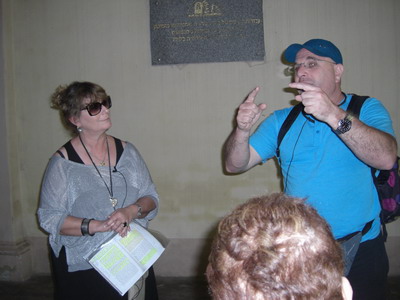
Our group of 45, organized by Nurit Goshen from the
Teachers’ Association was composed mainly of teachers and their
families and
friends and our exceptional guides, Rachel Volkenfeldt and Eyal
Mizrahi, who were
from Yad Vashem. The theme was "אם יש את נפשך לדעת את המעיין"" loosely
translated as “If you really want to
know the wellspring…”
Our week’s journey included visiting Warsaw, Lodz, Krakow
and Lublin and other towns and villages as well as the camps Auschwitz-
Birkenau, Majdanek, Treblinka, and Belzec.
On our first day we visited Lodz, known as the Manchester of
Poland. Rumkovski, the head of the Judenrat, was appointed by the Nazis
to
implement their policies. A flamboyant figure, he persuaded the Germans
to
exploit the Jews and develop Lodz Ghetto as a textile industry to
supply
Germans with uniforms, hand-woven insignia, underwear and dresses. He
believed
that being productive was the key to the survival of the ghetto
inhabitants.
Whoever did not have work did not get food rations, so the elderly and
children
under ten were destined for the gas chambers. He managed to get 9 year
olds
included as workers.
Rumkovski is best known for his speech, Give Me Your
Children, to ghetto inhabitants in 1942 where he reminds people
that
because he did not have children he always looked after them. Faced
with a
German demand to round up 20,000 children for the transports, he asked
the
residents to give up their children to save themselves. They did not.
In the
end, he too was sent to Auschwitz in August 1944. Roundly condemned for
many
years, there is more understanding today of his position. Appointed by
the
Nazis, he had to make impossible choices. Lodz, the first ghetto to be
founded,
was also one of the last to function.
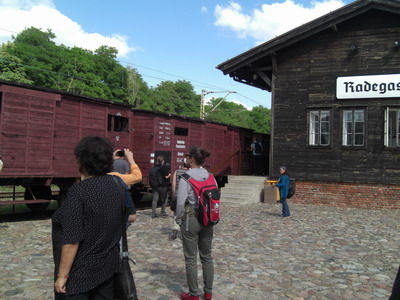
The train station at Radegast,
serving Lodz, was first used to bring materials for the textile
industry. And
later, for transports. The memorial complex has a long tunnel that
leads to a
real train carriage. In the tunnel are pictures of the Jews who were
transported
from Lodz to the Belzec death camp. Display cases hold articles dropped
accidentally
in the crush, either at the station or on the trains. One
box contained keys – people really thought
they would go back to their homes. At the station, people were squashed
into
train carriages meant for horses. Trains, under the Nazis, were not
only a
means of transportation but also part of their efficient death machine
– many
people died in the trains from heat or cold, from exhaustion, thirst
and
hunger. One survivor’s story recalled how her father was forced, like
all the
others, to urinate in a corner of the carriage. She said that at that
moment
her father died of shame, and not later when he was physically gassed.
In June 1941, when Germany invaded Russian in the Barbarossa
Campaign, local inhabitants of villages in Lithuania, Latvia and the
Ukraine, gladly
rounded up the local Jewish population. The Einsatzgruppen, Special
Task Forces
leading the Nazi invasion, ordered pits to be dug, usually in forests, either by locals or by the Jews themselves, The
Jews were then rounded up and shot, falling into the ditches. This
proved very
hard. No, not for the Jews, but for the German officers. Their work
schedule
was reduced and they were given as much free vodka as they wanted. But
still it
was hard. Then in 1941, Pavel, a mechanic at the first extermination
camp
Chelmo, had the idea of gassing Jews in lorries. Between 1941 and 1943,
330,000
people were asphyxiated in three air-tight lorries by exhaust fumes
as they were
driven from Chelmo to their place of burial. This was the first time
that mass
murder by gassing was used.
To make the killing machine more efficient,
Belzec,
Treblinka and Sobibor were built. These were Death Camps. The
overwhelming
majority of Jews who arrived by train were immediately gassed, but a
small
number of Jewish men were forced to become Sonderkommandos, burying the
dead in
mass graves, or burning the bodies on open-air pyres.
Majdanek and Auschwitz were Concentration Camps where
selection took place. On arrival the young, the old and the sick were
sent
immediately to the gas chambers. Those selected for life became slave
laborers
until they were too ill or weak to work and were killed.
Auschwitz-Birkenau, created in 1942, functioned
until August
1944, even after parts of Poland had been captured by Russia. Even when
they
were losing the war they continued their frenzy of killing and
Auschwitz-Birkenau was expanded to absorb trainloads of Hungarian Jews
destined
for the gas chambers. Unlike at the other Camps where the Jews were
gassed by
carbon monoxide, at Auschwitz the Germans used Zyklon B.
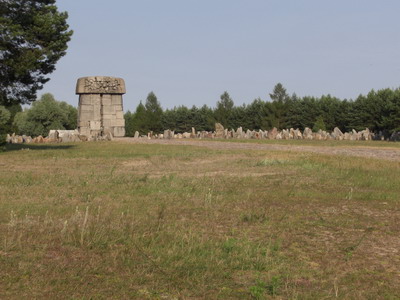
At Treblinka Germans supervised the camp, with
Ukrainians
helping with guard duty and murder. The first commander of the camp had
proved
unable to dispose of the huge number of bodies being gassed there. But
Stangl,
who had been involved in the ‘euthanasia’ of Germans who were
chronically ill or
suffering from mental disabilities, was well prepared to take over as
commander
of Treblinka death camp.
When the train transports arrived at Treblinka, those who
survived
the journey had to give up all valuables which were then sorted and
packed and
sent to Germany. The elderly and the sick were separated and sent to
the lazaretto
which flew a Red Cross flag. There they were shot in the head and burnt
in pits
behind the ‘infirmary.’
The others had to undress and after their hair was
shaved, they
were forced to run - to the gas chambers.
One survivor had to cut the hair of the prisoners.
Suddenly,
he saw his wife and mother approach. He could not tell them what was
about to
happen, but with infinite tenderness he took an extra 30 seconds and
slowly cut
their hair.
Treblinka was dismantled in August 1943 after a revolt by
300 Jewish slave laborers who escaped. The camp was totally
dismantled. The bodies that had been buried were exhumed and
burnt. The
ground was scattered with the human ashes, then furrowed and the area
became a farm.
This was to hide evidence of the 870,000 Jews who were murdered there
in 1 year
and 2 months by gassing. Today nothing remains of the camp and in its
place in
1960 a memorial was erected.
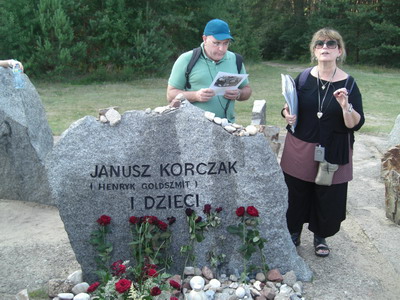
As we walked through the forest to the Treblinka memorial, the
path suddenly changed into a long line of raised concrete blocks
recalling
railway sleepers or ties. It ended in front of a raised platform,
symbolizing
the station. When you walked up onto the platform, everywhere you
looked there
were upright stones of different sizes, representing the size of Jewish
communities obliterated when their Jews were sent to Treblinka. Most of
the
stones are nameless. The largest stone at this symbolic cemetery
represents
Warsaw, from where 265,000 Jews were deported to Treblinka. Another
stone
represents the 43,000 Greek Jews murdered at Treblinka.
Only one stone bears the name of a private
person, Janusz Korczak, head of a Jewish orphanage in the Warsaw
Ghetto.
Although given the opportunity to disappear when the round-up of
children took
place, he chose to lead his orphans to the Umshlagplatz and together
with them boarded
the cattle car bound for Treblinka, never to be seen again..
I have visited The Valley of the Communities at Yad Vashem.
The visit is always at the end of a difficult day and it always seems
to be hot
and we are tired as we pass almost in a stupor through the maze of
names of towns,
of villages and cities from where the Jews came. Here
at Treblinka, was an endless field of
stones, 14,000 stones. They represent the obliteration of communities
sent only
to Treblinka.
Loss. Endless loss.
The magnitude of the destruction of Jewish communities
finally hit me.
During our week in Poland we also visited
Majdanek. It is
one of the most horrifying camps, so real and comprehendible in its
compactness.
Because of the rapid advance of the Russian army in July 1944, the
Germans
evacuated the camp before destroying all evidence of their crimes, only
partially managing to destroy the crematoria. Although 1,000 prisoners
had
already been sent on the Death March, thousands of prisoners, including
Russian
prisoners of war, survived to tell the Allied forces about the horrors
of the
camp.
It took us a whole day to walk through the enormous complex
of Auschwitz. One of our group recounted
the story of a relative who always walked clasping his hands behind his
back. He
kissed his children frequently but never touched them. When this
relative and
his family visited Auschwitz-Birkenau years later, he said he had
something he
had to tell his family. He told them
that during the war he was a Sonderkommando, forced to cremate the Jews
who had
been gassed. Every night the Sonderkommandos said Kaddish for the Jews
they had
placed in the crematoria that day. The man asked his family for
forgiveness and
explained that the reason he had never touched any of his children was
because
his hands were tainted with the death of fellow Jews. Then, he hugged
his
children.
In Krakow a simple memorial in Podgorze Square, the staging
area in the ghetto for transports, was erected. 17 large empty chairs
were spaced
around the square, symbolizing the 17,000 Jews transported to
Auschwitz-Birkenau. Opposite the square stands Afteka Pod Orlem. We were enthralled by the story of Tadeusz
Pankiewicz, a Pole, who insisted on keeping his
pharmacy in the ghetto functioning. He supplied the ghetto residents
with much
needed medicines, tranquilizers for children if needed during Nazi
raids and
even hair dye, to enable those who needed to leave the ghetto illegally
to go
unnoticed. He was later recognized as a Righteous among the Nations by
Yad
Vashem
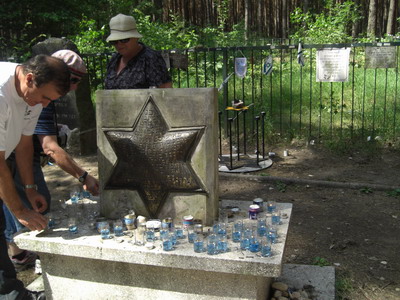
One of the most powerful moments was a memorial ceremony we
held in Lopuchowa Forest near the town of Tykocin in Bialystok
province. I
suspect you, like me, have never heard of it. It was overrun by the
Germans
when they invaded Poland, but was part of the area given to Russia
under the
non-aggression Ribbentrop-Molotov agreement signed a month after the
war
started.
In June 1941 during Operation Barbarossa, Germany invaded
Russia, and ended the quiet of Tykocin village. One morning in August,
all able-bodied
Jews were ordered to present themselves at the town square. When they
asked their
learned rabbi whether they should comply, he said that he remembered
the
Germans as gentlemen from WWI and that they had nothing to fear. After
being
transported to a nearby town and locked in a school building,
successive groups
of Jews were forced to sing while being whipped during a forced-march
to Lopuchowa
Forest. Deep in the forest, they were shot in such a way as to fall
into three
previously dug ditches. During the
following
few days, over 2,100 Jews were shot and buried.
As our group stood in front of these mass graves, we held a
ceremony for all Jews who were murdered in the forests by the Nazis and
their
corroborators. When Kaddish was being recited I found myself sobbing,
sobbing for
my grandparents who were murdered at Ponar in Vilna. How can I mourn
grandparents I never knew? The feeling
of loss, the loss of not having known them, was overwhelming. My
father, helped
by his uncle Joe, emigrated to South Africa, and when my father had
saved
enough money, he brought out his brother Mike. Their grandmother,
parents and youngest
brother remained behind. My grandfather Mottel and his son Abraska were
among
the first men to be picked up off the streets of Vilna and
force-marched to
Ponar where they were murdered. Nessie, my father’s mother ran away and
was
burnt alive in a synagogue. I am always haunted by the image of my
grandmother,
first saying goodbye to my father and then to her second son Mike when they left for South Africa, knowing that she
would never see them again. And so I wept for her, and for my father
who was
tormented that he could not save his family, and for me.
Here, in the forest, I was able to read aloud
family names,
and to remember:
Feige
Blume Dagim, my great grandmother who died in Vilna
Ghetto 1943
Mottel Glazer, my grandfather, Ponar August
1941
Abrashka Glazer, my uncle, Ponar
August 1941
Nessie Shank, my grandmother, Olshan
Belarus 1942
My father’s cousins
and their spouses:
Henia Glasser, Ponar December 1941
Yehuda Kagan, Ponar December 1941
Israel Kagan, Ponar 1944
Aaron Mil Germany 1945
Elke Trotsky Mil, Stuthof
Concentration Camp Germany 1945
יהיה
זכרם ברוך
At the end of the war most of the survivors made their way
to Israel. Many managed to rebuild their lives, have children and even
very
successful careers. Looked at in askance when they first arrived, the
hidden
question was “What did you do to survive?” and the survivors didn’t
speak. Today,
as the generation of survivors diminishes, they are eager to share
their previously
untold stories of courage and survival, and all proudly recount the
number of
children and grandchildren they have.
One of the lessons to be learnt from the Shoah is
that there
must always be a homeland, a place of refuge, for Jews. For despite
having
learnt so much on this journey, it remains incomprehensible how human
beings
could act so monstrously to other human beings. How sadism and
brutality became
the accepted norm, still remains a mystery to me.
May
we always be on our guard that
it may never happen
again to any people.
RETURN TO TOP OF PAGE
GO TO HOMEPAGE OF
DOREEN and EITAN LEVY
..